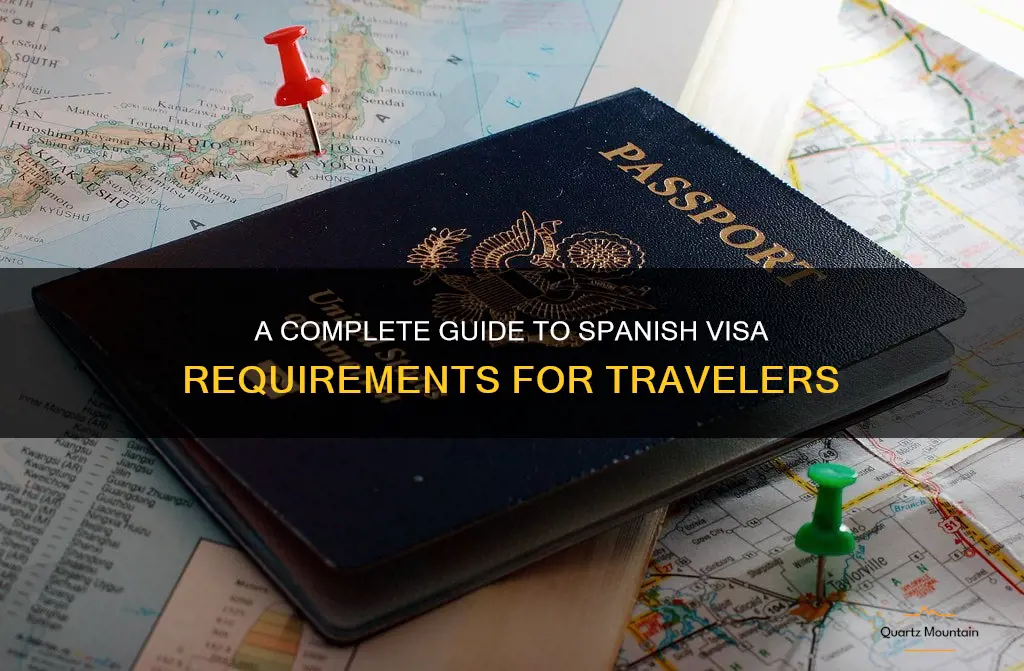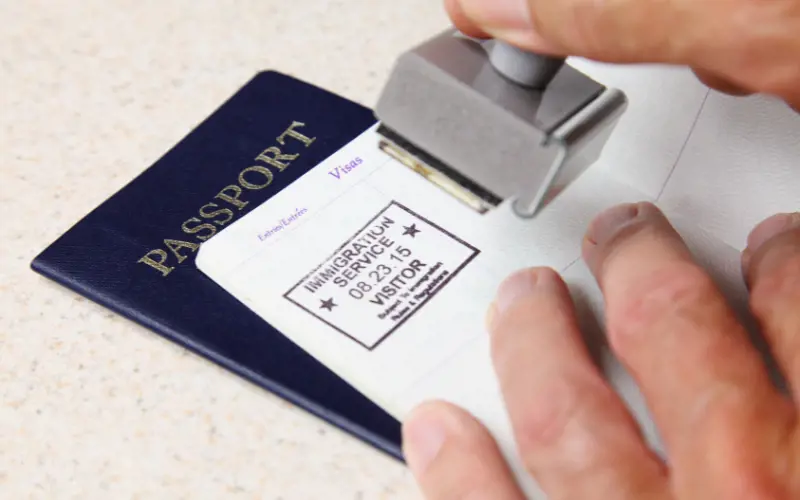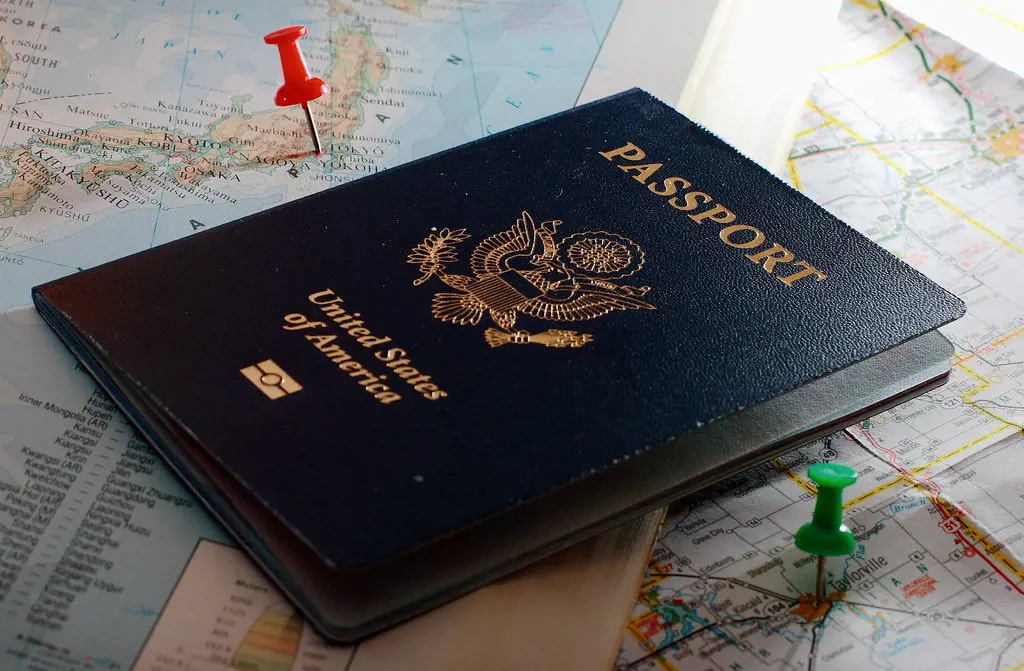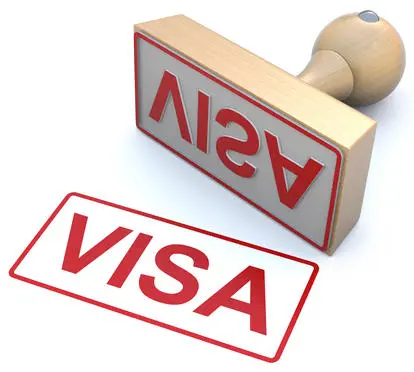
Are you dreaming of wandering through the vibrant streets of Barcelona, sipping sangria and indulging in tapas? Planning a trip to Spain is filled with excitement, but before you can step foot in this beautiful country, there are a few important things you need to know about Spanish visa requirements. In this complete guide, we will walk you through the process of obtaining a visa, whether you are traveling for leisure, work, or study. From the necessary documents to the application process, we've got you covered. So grab a pen and paper, and let's dive into the world of Spanish visas!
| Characteristic | Value |
|---|---|
| Visa required | No |
| Valid passport required | Yes |
| Length of stay without a visa | 90 days |
| Nationalities exempt from a visa | EU countries, United States, Canada, Australia, New Zealand |
| Length of passport validity required | 3 months |
What You'll Learn

Visa Requirements for Spain

Spain is a popular destination for tourists, students, and professionals alike. If you are planning to visit Spain, it is important to know the visa requirements and the different types of visas available. In this blog post, we will discuss the types of visas for traveling to Spain and the visa exemption for certain nationalities.
Types of visas for traveling to Spain:
- Schengen Visa: This is the most common type of visa for traveling to Spain and is valid for short stays of up to 90 days. The Schengen Visa allows you to travel to Spain and other Schengen countries. It is typically issued for tourism, business, or medical treatment purposes. To apply for a Schengen Visa, you will need to provide a valid passport, travel itinerary, proof of sufficient funds, and health insurance.
- Student Visa: If you are planning to study in Spain for a longer period, you will need to apply for a student visa. This visa allows you to stay in Spain for the duration of your studies. To apply for a student visa, you will need to provide an acceptance letter from a Spanish educational institution, proof of financial means to support yourself, and a valid medical insurance policy.
- Work Visa: If you have a job offer in Spain, you will need to apply for a work visa. This visa allows you to work and live in Spain for an extended period. To apply for a work visa, you will need to provide a job contract or a letter from your employer, proof of specialized skills or qualifications, and a valid medical insurance policy.
Visa exemption for certain nationalities:
Spain has visa exemption agreements with several countries, allowing citizens of those countries to enter Spain without a visa for short stays. Some of the countries that have visa exemption agreements with Spain include the United States, Canada, Australia, New Zealand, and members of the European Union. Citizens of these countries can enter Spain for tourism, business, or medical treatment purposes without a visa for up to 90 days.
However, it is important to note that even if your country has a visa exemption agreement with Spain, you will still need to meet certain requirements to enter the country. You must have a valid passport with at least six months of validity, a return or onward ticket, and proof of sufficient funds to support yourself during your stay.
In conclusion, if you are planning to travel to Spain, it is important to be aware of the visa requirements and the different types of visas available. Whether you are visiting for a short stay or planning to study or work in Spain, make sure to gather all the necessary documents and apply for the appropriate visa. Remember to check if your country is eligible for a visa exemption agreement with Spain and ensure you meet all the entry requirements.
Exploring the Possibility: Traveling with an Expired Visa
You may want to see also

Schengen Visa for Spain

The Schengen Visa is a travel document that allows visitors to enter, travel within, and leave the Schengen Area freely. The Schengen Area is an area comprising 26 European countries that have abolished passport and other types of border control at their shared borders. This means that once you obtain a Schengen Visa for Spain, you can travel to any of the other Schengen member states without any additional travel documents or restrictions.
Understanding the Schengen Area:
The Schengen Area includes 22 European Union (EU) member states and 4 non-EU member states. These countries have signed the Schengen Agreement and follow its rules and regulations to maintain border-free travel. Some of the popular destinations in the Schengen Area include France, Germany, Italy, Spain, Greece, Sweden, and many more.
Applying for a Schengen Visa for Spain:
If you are planning to visit Spain and explore the other countries in the Schengen Area, you will need to apply for a Schengen Visa. Here is a step-by-step guide on how to apply for a Schengen Visa for Spain:
Determine your visa type:
There are three main types of Schengen Visas: Uniform Schengen Visa (USV), Limited Territorial Validity (LTV) Visa, and National Visa. The Uniform Schengen Visa is the most common type and allows you to travel within the Schengen Area for a maximum of 90 days. The Limited Territorial Validity Visa allows you to travel only within a specific country or countries. The National Visa is for those who wish to stay in Spain for more than 90 days.
Gather the required documents:
To apply for a Schengen Visa for Spain, you will need to gather the following documents:
- A completed visa application form
- A valid passport with at least 3 months validity beyond the intended stay in Spain
- Two recent passport-size photos
- Travel medical insurance
- Proof of accommodation in Spain (hotel reservations, rental agreement, etc.)
- Proof of financial means to cover the trip (bank statements, sponsorship letter, etc.)
- Flight itinerary or proof of transportation
Make an appointment:
You will need to schedule an appointment at the Spanish consulate or embassy in your country of residence. It is advisable to do this well in advance, as the appointment slots may get filled quickly, especially during peak travel seasons.
Attend the visa interview:
On the day of your appointment, make sure to arrive early and bring all the required documents. The visa officer will ask you questions regarding your purpose of visit, travel plans, and financial resources. Be prepared to answer these questions honestly and confidently.
Pay the visa fee:
There is a non-refundable visa fee that you will have to pay when submitting your application. The fee varies depending on your visa type and country of application. Make sure to have the exact amount in cash or be prepared to pay via a specific payment method accepted by the consulate or embassy.
Track your visa application:
After submitting your application, you will receive a tracking number or reference number that you can use to track the status of your visa application online. It may take several weeks for the visa to be processed, so be sure to check the status regularly.
Collect your visa:
Once your visa application is approved, you can collect your visa from the consulate or embassy. Make sure to bring your passport and any other documents requested by the consulate. Check the visa for any errors or discrepancies before leaving the consulate.
Once you have obtained your Schengen Visa for Spain, you are ready to explore the beautiful country and travel freely within the Schengen Area. Remember to adhere to the visa conditions and enjoy your trip to the fullest!
Visa Requirements for American Travelers Visiting Switzerland
You may want to see also

Visa-Free Travel to Spain

Spain, with its stunning landscapes, rich culture, and vibrant cities, is a popular destination for travelers from all around the world. Fortunately, citizens of many countries are eligible for visa-free travel to Spain, allowing them to enjoy everything this beautiful country has to offer without the hassle of obtaining a visa.
Countries Eligible for Visa-Free Travel to Spain:
- European Union and Schengen Area Countries: Citizens of all European Union member countries, as well as countries within the Schengen Area, can travel to Spain without a visa. These countries include Germany, France, Italy, Sweden, and many others.
- United States, Canada, and Australia: Citizens of the United States, Canada, and Australia can also enjoy visa-free travel to Spain. This means that you can explore the stunning architecture of Barcelona, visit the vibrant capital city of Madrid, or relax on the pristine beaches of the Costa del Sol without the need for a visa.
- Latin American Countries: Citizens of most Latin American countries, including Argentina, Mexico, Brazil, and Chile, can travel to Spain without a visa. This opens up a world of opportunities for travelers from these countries to immerse themselves in Spanish culture and history.
- Asian and African Countries: Citizens of certain Asian and African countries are also eligible for visa-free travel to Spain. These countries include Japan, South Korea, Malaysia, Morocco, Tunisia, and South Africa, among others.
Duration of Stay without a Visa:
For most visa-free travelers, the duration of stay without a visa in Spain is limited to 90 days within a 180-day period. This means that you can stay in Spain for up to 90 consecutive days or spread your visits over multiple trips within a 180-day period. It is important to keep track of the number of days you have spent in Spain to avoid overstaying and potential immigration issues.
If you wish to stay in Spain for longer than 90 days, you will need to apply for a visa or a residence permit, depending on the purpose and duration of your stay. The specific requirements and procedures may vary depending on your country of citizenship, so it is recommended to consult the nearest Spanish embassy or consulate for accurate and up-to-date information.
Traveling to Serbia with a Schengen Visa: What You Need to Know
You may want to see also

Visa Application Process for Spain

Spain is a popular destination for tourists, students, and professionals alike. If you are planning to travel to Spain for work, study, or tourism purposes, it is essential to understand the visa application process. In this blog post, we will guide you through the required documents for a visa application, filling out the visa application form, as well as the appointment and interview process.
Required Documents for a Visa Application
When applying for a visa to Spain, it is crucial to have all the necessary documents ready to avoid any delays or complications. The required documents may vary depending on the purpose of your visit, so be sure to check the specific requirements for your visa category. However, there are some common documents that are typically required for a visa application:
- Passport: Make sure your passport is valid for at least three months beyond the intended date of departure from Spain.
- Visa Application Form: Fill out the visa application form accurately and legibly. Avoid leaving any sections blank, as incomplete forms may lead to the rejection of your application.
- Photographs: Attach recent and passport-sized photographs that meet the specifications outlined by the embassy or consulate.
- Proof of Travel Insurance: Provide a valid travel insurance policy that covers medical and hospitalization expenses, with a minimum coverage of 30,000 euros.
- Proof of Accommodation: Present documentation such as hotel reservations or an invitation letter from a host in Spain to confirm your accommodation arrangements.
- Financial Means: Demonstrate that you have sufficient funds to cover your expenses during your stay in Spain. This can include bank statements, pay stubs, or a letter from your employer.
- Employment or Educational Documents: If you are traveling to Spain for work or study, you will need to provide documents such as an employment contract, acceptance letter from a Spanish educational institution, or proof of enrollment.
- Flight Itinerary: Include a copy of your round-trip flight itinerary that confirms your travel dates and flight details.
Filling Out the Visa Application Form
The visa application form is a crucial part of the visa application process and must be filled out accurately. Here are some tips to help you in filling out the visa application form:
- Read the instructions carefully: Before filling out the form, read the instructions provided by the embassy or consulate. This will help you understand the specific requirements and avoid any mistakes.
- Use capital letters: Write your name, address, and other personal details in capital letters to ensure clarity and legibility.
- Be concise and precise: Answer the questions on the form concisely and precisely. Avoid unnecessary information or lengthy explanations.
- Provide accurate information: Double-check all the details you provide to ensure accuracy. Any inconsistencies or errors may lead to delays or rejection of your application.
- Sign the form: Remember to sign the completed visa application form. Unsigned forms are considered incomplete and may be rejected.
Appointment and Interview Process
After gathering all the required documents and filling out the visa application form, you may need to schedule an appointment at the Spanish embassy or consulate in your country. The appointment is typically required for a visa interview, where you will be asked questions about your travel plans and purpose of visit.
During the interview, it is essential to remain calm, confident, and provide truthful answers. Dress appropriately and bring all the original documents along with copies in case they are requested by the consular officer.
After the interview, the consular officer will inform you about the visa processing time. It is important to note that visa processing times can vary depending on the embassy or consulate, so it is advisable to apply well in advance.
In conclusion, the visa application process for Spain requires careful preparation and attention to detail. By gathering all the necessary documents, accurately filling out the visa application form, and being prepared for the interview, you increase your chances of a successful visa application. Remember to familiarize yourself with the specific requirements for your visa category and follow the instructions provided by the embassy or consulate. Good luck with your visa application!
Exploring the Possibility of Traveling to Canada with a US Visa
You may want to see also
Frequently asked questions
No, most travelers from countries within the European Union (EU) and the Schengen Area do not need a visa to visit Spain. This includes citizens of countries such as the United States, Canada, Australia, and Japan, who are allowed to stay in Spain for up to 90 days within a 180-day period without a visa.
Travelers from visa-exempt countries can stay in Spain without a visa for up to 90 days within a 180-day period. This means that you can visit Spain for up to 90 days, but you must then leave and wait at least 90 days before returning for another 90-day period.
Yes, citizens of countries that are not part of the EU or the Schengen Area will generally need a visa to visit Spain. The specific visa requirements and application process may vary depending on your country of citizenship, so it is important to check with the Spanish embassy or consulate in your home country for the most accurate and up-to-date information.
If you wish to stay in Spain for longer than 90 days, you will generally need to apply for a long-term visa or a residence permit. These permits are typically granted for specific purposes such as work, study, or family reunification. The process and requirements for obtaining a long-term visa or residence permit will vary depending on your circumstances.
If you are transiting through Spain on your way to another destination, you may not need a visa as long as your stay is short and you do not leave the international transit area of the airport. However, if you plan to leave the airport and enter Spain during your transit, you may need to apply for a transit visa or a short-stay visa, depending on your country of citizenship. It is important to check the specific transit visa requirements with the Spanish embassy or consulate in your home country before your travel.







